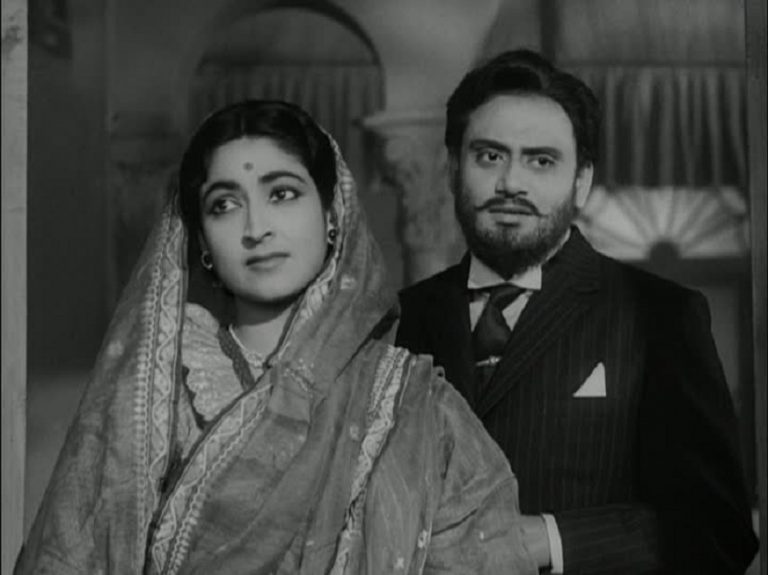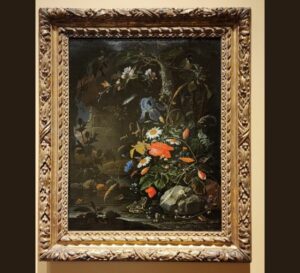Manihara, published in the second volume of Galpaguchcha in 1901, was one of the three short stories chosen to be part of Satyajit Ray’s Teen Kanya (Three Daughters, 1961). Ray’s film segment is unambiguously a ghost story, told to the ghost by an unwitting schoolmaster narrator who is terrified when his audience discloses being the subject of the story and vanishes into thin air. Tagore’s story is more complex, though presented in a similar flippant style, mixing sarcasm with narratorial interventions. Some of the lingering questions have several possible answers, as outlined in this article.
Let us start with the plot. The story is written in the first person. But that person, unnamed until the very end, is the audience of the schoolmaster’s story. There are, therefore, two layers of narration in Tagore’s story. The ghost story is narrated by the schoolmaster to an unnamed traveler, which the traveler then relays to us, the readers. The traveler has just arrived by boat and is resting before entering a crumbling mansion, the sight of which elicits a sigh from him. Before long, however, a stranger appears and introduces himself as a schoolmaster by profession and writer by hobby, and volunteers to tell the traveler the history of the mansion. The nameless schoolmaster reminded the traveler-narrator of the ancient mariner from Coleridge’s poem, Tagore writes.
The schoolmaster’s story involved a couple—the master of the mansion Phanibhushan Saha, and his wife Manimalika. Phanibhushan, a merchant who had prospered from colonial trade (though on a scale limited than that of someone like Prince Dwarkanath Tagore, Rabindranath’s grandfather), lived in the mansion with his wife Manimalika until her mysterious disappearance, when Phanibhushan was away attending to a financial crisis in his business. Her jewels, which she loved more than she loved her husband or anyone else, were gone too, and so was her distant cousin, a shady character who was employed in their household.

After Phanibhushan returned, he and his manager tried to locate Manimalika in vain. The empty mansion began casting a spell on Phanibhushan’s mind, who started to wait in the dark every night for Manimalika—dead or alive—to return to him. After several nights of waiting, Manimalika’s ghost, a bejeweled skeleton, showed herself and signaled him to follow her to the riverbank. As the skeleton walked into the water, so did Phanibhushan, and he drowned.
Here is where the schoolmaster’s narrative ends, and the traveler’s narration (to us) resumes. Here is a quick and informal translation of the concluding section of the story.
I [the traveler] did not speak for a long time. He [the schoolmaster] asked me, “Did the good sir not believe in my story?” I asked, “Do you believe it?” He said, “No, because Lady Nature is not a novelist; she has plenty of other things to do, and ….”
I said, “and secondly, I am Phanibhushan Saha.” Unabashed, the schoolmaster said, “I had guessed correctly, then. What was your wife’s name?” I replied, “Nrityakāli.”
That’s where Tagore stops. We can imagine the schoolmaster and Phanibhushan parting ways after this, moving on with their respective lives. In Ray’s film, Phanibhushan himself is a ghost, who fades into the background after declaring his name. There is no further mention of Manimalika/Nrtiyakāli. The schoolmaster is spooked by the disappearance of the ghost of Phanibhushan and makes a quick, almost comical exit.
The film is therefore spooky, but not mysterious. The schoolmaster, who is named, is a reliable narrator, who had the one-in-a-zillion storyteller’s experience of telling a ghost story to the ghost. But Tagore’s short story is, I repeat, much more complicated. In Tagore’s version, the schoolmaster is an unwelcome intrusion into the traveler’s privacy, and the schoolmaster’s worldview, as reported by the traveler, is dominated by a verbosely pedantic misogyny (which can be summarized as ‘women need to be and love to be controlled by men’). What is the use of the schoolmaster’s convoluted ideology in this ghost story? We are left with nothing less than a riddle here.
Bibliographic and biographical sources tell us that Tagore, visiting Darjeeling 1896 with Rathindranath and Dinendranath, had improvised the story at the request of Suniti Debi, the Maharani of Cooch Behar. As Tagore reminisced in a letter to Hemantabala Debi in 1936, Suniti Debi frequently requested him to tell a story, and it was on one such occasion, while they were strolling through the streets of Darjeeling, that Tagore constructed ‘Manihara’ as a ghost story. It is impossible to surmise if Tagore iterated in the first oral version all the misogynistic rant that punctuates the schoolmaster’s narrative. If the answer is ‘no,’ then why was all that added later? If ‘yes’ then how did Suniti receive it? After all, she was a progressive woman: an active campaigner for women’s education and an author (incidentally, her father was Keshab Chandra Sen, the 19th century reformer). Did a 36-year-old Tagore, a tall lean figure with his elaborate couture and careful grooming seem like an antithesis of the unkempt and frayed ancient mariner that the schoolmaster in ‘Manihara’ resembled? Did they share a common contempt towards middle-class Bengali men, many among whom thought and spoke of women like the schoolmaster did?

While we may not correctly guess the level of details in Tagore’s impromptu narration to Suniti Debi, we can appreciate the twist that Tagore introduces in the conclusion, by refuting the schoolmaster’s story, and by replacing the wife’s beautiful name Manimalika with the rustic and decidedly old-fashioned Nrityakali (literally meaning the dancing Kali, whom her husband Siva had to stop by laying down in front of her). Tagore’s heroines have beautiful names, and Nrityakali does not fit the bill. But since ‘Manihara’ is all about telling tales, we as readers can get in the game by considering Tagore’s wordplay on the names. The traveler merchant’s name is Phanibhushan, which literally means ‘one who wears the snake as an ornament’, and specifically refers to Siva. What better name than Nrtiyakali can Phanibhushan’s wife have? For the Bengali reader, the name Phanibhushan recalls an idiomatic expression too, manihara phani, or the mythical snake/phani whose hood is missing the jewel/mani, representing someone who is missing their most valuable attribute or belonging. Mani means gem or jewel and can stand for the missing jewels in the story, or for Manimalika herself, or for Phanibhushan’s lost wealth. Which one is the ‘mani’ in Tagore’s title for the story? Who or what is mani-hara or mani-less? Is it Phanibhushan in the schoolmaster’s story, or Phanibhushan the traveler in Tagore’s story, or is it the actual yet-to-be-told history of the mansion that is missing Manimalika because there never was anyone named Manimalika?
[PS: the details regarding the background of the story are gathered from Rabindra-rachanabali, Volume 21 (Sulabh Sanskaran), and from Prashanta Kumar Pal’s Rabijibani, Volume 4.]




























One Response
চমৎকার